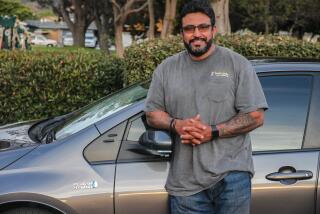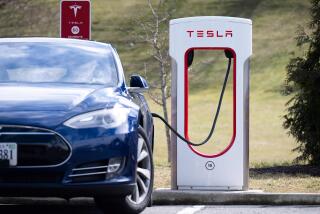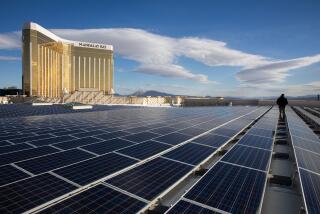Students Race With the Sun in Solar Car Competition
- Share via
The sun pushed a car up the Conejo Grade on Saturday.
Scaling a notorious grade that some gas-powered automobiles have trouble with, the funny-looking car reached the summit at 30 to 35 m.p.h. at about 10:45 a.m., powered only by the sun’s rays.
The 604-pound car from Western Washington University was the first of seven solar-powered cars that drove through Ventura County on Saturday in a six-day race from Sacramento to Los Angeles.
First prize in the California Clean Air Race is $5,000, to be divided among the college-student team members, race officials said.
The race will not end until this afternoon at the California Museum of Science and Industry, but it was clear on Saturday that the students from Western Washington University would finish hours ahead of their competitors from other colleges.
“Everyone knows Western is going to win, so they’re all kicking back and having fun,” said Eric Cusick, a race official who was waiting for cars at a pit stop at Camarillo City Hall.
As of Saturday, Western Washington University’s entry, Viking XX, was about five hours ahead of its rivals, Cusick said.
“Western is an example of what you can do with a solar car if you have the people, money and knowledge,” said Alex Tilson, who helped design Stanford University’s car.
Cusick, who is a civil engineering major at California Polytechnic State University, San Luis Obispo, agreed.
“They use a satellite cell to convert sunlight,” Cusick explained. “It’s the top grade that NASA uses.”
Western has also been able to outrace its competition because its batteries, which store the energy harnessed by solar cells, are extremely light compared to other cars, Cusick said. The silver zinc batteries are more expensive but weigh less than the lead acid batteries of the other cars, Cusick said.
Batteries in solar-powered cars are used primarily to accelerate, climb hills and travel at higher speeds, Cusick said. The rest of the time, the cars glide along only on sun power. The challenge in building a solar-powered car comes in getting the maximum exposure to the sun while keeping the vehicle’s weight as low as possible.
Western’s car was designed so that the solar panels on top can get maximum exposure to the sun, said Jason Boyle, a driver with the team. No matter where the sun is, the car can be turned so the panels catch the rays, he said.
The car has been entered in two other solar car races and placed well, Boyle said. Corporate sponsors paid for the $350,000 vehicle, he said.
Solar-powered cars are “the supreme engineering challenge,” Tilson said, and are still too expensive and impractical for general use.
“Solar cars are not a good idea. You just don’t get too much power, and it limits the design too much,” Tilson said. The cars carried no more than two people, and the low, jet-like craft did not appear to be designed with comfort in mind.
But Mauri Trevino, who helped design the entry from the University of Texas, Austin, is more optimistic. He predicted that electric-powered cars will become popular, “and eventually solar will overtake electric, because it will be more readily available.”
As of now, however, solar-powered cars generate too little power, Trevino conceded. Even Western’s car can only boast about 1,800 watts.
“That’s enough to run a good hair dryer,” said Randy Weaver, who will be driving Western’s car to the finish line today.
Anything over 45 m.p.h. is considered fast for a solar-powered car, Cusick said. During the race, all the cars were escorted by California Highway Patrol officers, who pulled drivers over if they slipped below 30 m.p.h. so faster-moving traffic could pass, Cusick said.
As a race official following in a “chase car,” Cusick said, he also pulled over drivers if they backed up traffic on the many two-lane highways they traveled.
“I made Western pull over 10 times on the freeway from Fresno,” he said.
Despite some of the advantages of owning a solar-powered car, Phil Johnson, a Ventura resident who was in Camarillo to see the cars, said he wouldn’t buy one. “It didn’t look like any other vehicle I’d seen before,” he said.
Western’s pace-setting team planned to spend Saturday night in Northridge. Like the other solar racers, they don’t get far at night.
More to Read
Sign up for Essential California
The most important California stories and recommendations in your inbox every morning.
You may occasionally receive promotional content from the Los Angeles Times.













